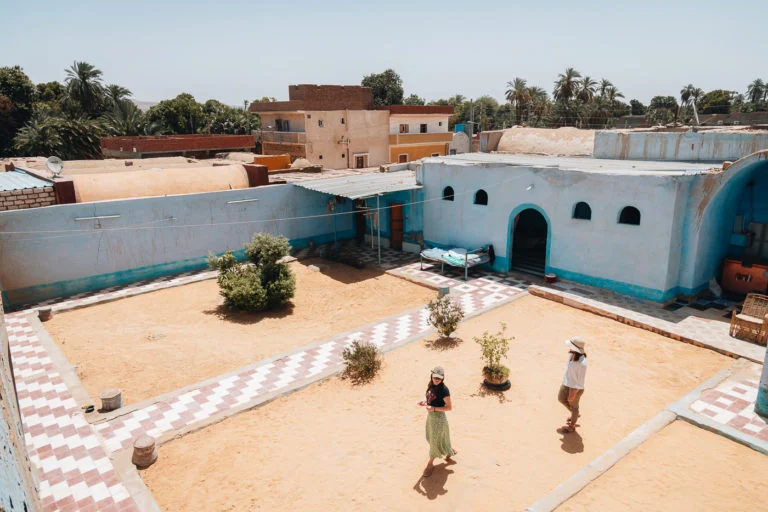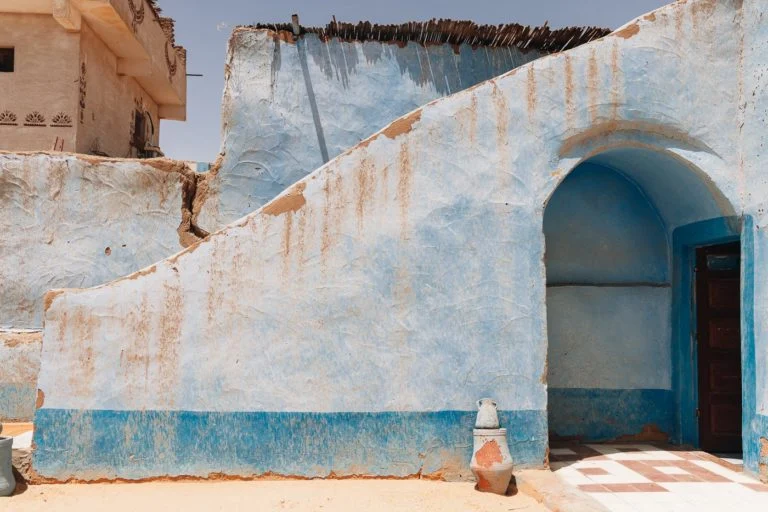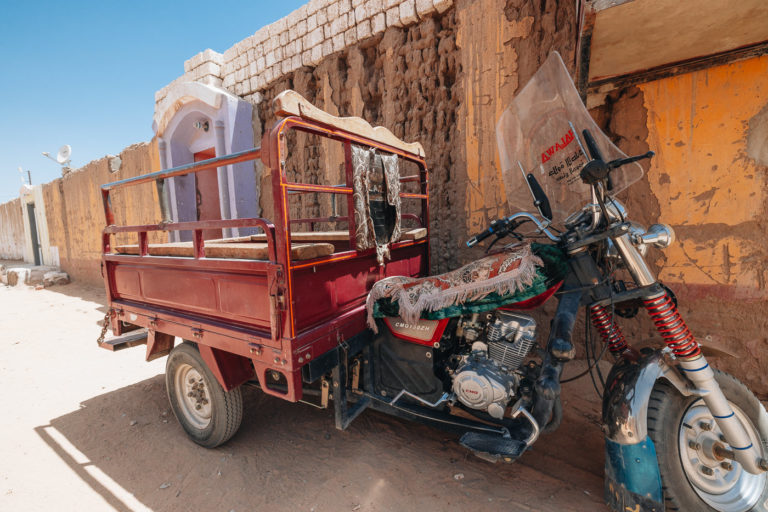HOW TO VISIT A TRADITIONAL NUBIAN VILLAGE IN ASWAN, EGYPT
Are you ready to be humbled by some of the friendliest people on earth? Read this guide on how to visit an authentic Nubian Village from Aswan, Egypt.
Far upstream on the Nile, in Upper Egypt lives one of the oldest civilizations, the Nubians. These friendly people have occupied the Western Banks of the River Nile near Aswan for as long as 8,000 years!
Visiting a colorful Nubian Village from Aswan is an authentic and rich travel experience that is guaranteed to leave you with invaluable memories and new lifelong friends.
About The Nubian People Of Egypt
Most tourists come to the land of the Pharaohs to witness its amazing Egyptian landmarks and historical monuments.
While undoubtedly fascinating, to really experience Egypt I urge all travelers to also open their hearts to the amazing people and cultures of the land. To get to know the Nubians, here are a few quick notes summarizing their unfathomably ancient history.
Nubia In Ancient Times
The historical homeland of the Nubians encompasses a southern region of the Nile River. This land stretches between the first cataract of the Nile and the points where the Blue and White Niles meet.
The people of ancient Nubia harbor one of the oldest cultures on the planet. In fact, their history precedes that of the dynastic Egyptians by millennia!
They are descendants of the Khartoum Mesolithic culture. In ancient times, this was a highly advanced civilization responsible for some of the oldest sophisticated pottery in the world. Historians also know them for building one of the world’s first astronomical devices. They discovered this at the megaliths of Nabta Playa and it predates Stonehenge by almost 2,000 years!
Originally migrating from Northern Sudan around 6,000 BCE, the Nubian people settled in Southern Egypt as livestock herders. Initially nomadic, they moved their sheep, goat, and cattle across the lands North of Sudan.
Along the way, they settled into villages and began primitive farming. Due to this, historians call the Nubians the cradle of civilization and one of the forebearers of farming.
Living Alongside The Ancient Egyptians
The Ancient Egyptians as far back as 3300 BCE called Nubia Ta-Seti, or The Land of the Bow. This is because they regarded the Nubian warrior as an expert archer, developed after thousands of years of bowhunting.
Over the thousands of years of history that followed, relationships of peaceful cultural and trade relations existed alongside periods of war and conflict with the Ancient Egyptians. However, the two cultures and ethnic groups are very much intertwined. Over time, the dark skin Nubian bowmen assimilated into Egyptian culture, married Egyptian women, and even were even buried in Egyptian style.
Needless to say, the Nubian people played a vital role in the history of Ancient Egypt and for long periods ruled a prosperous and highly respected civilization
Nubia Today
In modern times, Nubia was divided between Egypt and Sudan after the establishment of the Republic of Egypt and the secession of the Republic of Sudan in Egypt.
Today, the Egyptian Government controls the historical homelands of the Nubian people. As a result, modern-day Nubians are considered Egyptian, are mostly Muslim, and speak the Arabic Language. However, they also still retain their own unique language and culture.
Unfortunately, Nubian villages have been forcibly relocated several times in the past few decades due to the expansion of Lake Nasser from the Aswan high dam and low dam projects.
Nubian villages are now mostly located on the west bank of the Nile near Aswan and on Elephantine Island. The city of Gharb Soheil is one of the most famous near the first cataract of Aswan.
Modern Nubian Egyptians in Aswan are mostly farmers and herders but also rely heavily on tourism. Visiting a Nubian Village in Egypt is a great way to direct your tourist dollars to communities that need it.
Tip: you can learn more about Nubian culture and history at the Nubian Museum in Aswan.
How To Visit A Nubian Village In Aswan
During our three days in Aswan, I visited two different Nubian Villages. We also shared a campfire with some of the families far up on the Nile. This was organized as part of the 9-day essential Egypt trip with TravelTalk Tours.
TravelTalk works directly with several Nubian Villages on the Nile and employs dozens of local families to run their felucca sailing experiences (also a must!).
If you’re still in the planning stage of your Egypt itinerary, I highly recommend checking out their tours. In my opinion, this is the best way to visit an authentic Nubian Village in Egypt!
While you can also book a day trip with a tour guide in Aswan, on a private day tour, or as part of a Nile Cruise, I recommend thoroughly checking reviews first.
I’ve been told many of these offerings feel a little inauthentic and it isn’t exactly clear how much of your money is actually going to the Nubian people hosting you in their village.
The Boat Trip
Since most of the colorful villages are located on the west bank of the Nile River, you’ll need to take a short boat ride to reach them. Depending on your trip, this will usually be in a small boat with an outboard engine or a modern motorboat.
These depart from a small port in Aswan but will also pick you up from your hotel if you’re staying on the banks of the river.
As I mentioned earlier, we visited the villages as part of a felucca sailing journey down the Nile.

Visiting A Nubian VIllage In Egypt – What To Expect
No matter which Nubian Village you visit in Aswan, you’ll likely experience the same friendly welcome typical of Nubian culture.
So, to help you understand what to expect, I’ll give you a quick recap of my experience below.
Exploring The Colorful Nubian Houses
After crossing the Nile, we were led by a local tour guide through two beautiful villages. Here we wandered the streets and admired the unique architecture and colorful designs of their houses and buildings.
Nubian houses are often brightly colored in light blue, orange, yellow, and red tints. Their roofs are usually curved or dome-shaped, which is a practical design used to trap hot air in the blistering Sahara.
These are mostly mudbrick buildings and are always adorned in bright colors with unique painting designs. I also noticed some had images of Horus and other deities painted on the outside walls.
Outside of the buildings, you’ll often find many palm trees and small crops. The dark green crop you’ll likely see is alfalfa, which they grow to feed their livestock.
Amazing Hospitality In Nubian Village Life
After a stroll through the village, we were invited in for a hibiscus or Morrocan mint tea by a local Nubian family.
Later, the owner was very eager to show us around her beautiful house, which consisted of a large, open courtyard complex. Around the courtyard, several single-door rooms were facing inwards. I was told that we’d find this design in almost every house in the village, as it provides a place where families can gather and share a meal.
At first, I felt a little uneasy walking through and peaking into her house, but the local kids soon grabbed us and took us for a tour, to the delight of the parents. It was humbling to see how open Nubian Village life is, and how excited they were to show us how they live.

A Meal With The Nubians
One of the evenings while we were traveling with TravelTalk, we were invited to a meal at another traditional Nubian house. Our host served us traditional food which included a spiced chicken dish, rice, falafel, fresh salads, and homemade flatbread.
Before we knew it, it was as if the whole community had shown up. They began singing and dancing, and soon enough we were all in as well!
If you are invited to a Nubian Dinner, or if this is an option on one of the tours, I highly recommend it, it’s easily one of the best things to do in Aswan!
Can You Stay In A Nubian Village?
Yes, you can! There are loads of colorful guest houses and hotels right on the shores of the Nile’s west bank! Below I’ve linked to a few well-rated Nubian accommodation options.
- Kato Dool Resort – a beautiful and colorful hotel right on the Nile that you’ll likely have seen photos of on Instagram already!
- Anakato – another colorful and amazingly decorated B&B with an awesome courtyard and rooftop.
- Nubian Farm – a traditional homestay where you can live in true local style at a family farm.
Where To Stay In Aswan
Prefer to visit the Nubian Villages on a day trip from Aswan? Here are the top-rated picks for accommodation on the east bank for every budget.
The most popular areas to stay in Aswan include the city center, where you’ll find a mix of budget-friendly and upscale hotels, as well as plenty of restaurants, cafes, and shops. Alternatively, Elephantine Island, accessible by boat offers one-of-a-kind views of the Nile River.
The new upscale resort area of New Aswan is also a great option for luxury hotels and spas.
Don’t miss this comprehensive guide to the best hotels in Aswan, or take a peek at the three top picks for each budget below.
- Sofitel Legend Old Cataract – Located in the Nubian Desert 1.3km from Aswan center the hotel offers excellent views and 5-star service. The rooms are beautifully designed and decorated and feature an indoor and outdoor pool, spa, and fitness facilities.
- Tolip Aswan Hotel – A perfect choice for those not wanting to break the bank but still want to experience 5-star luxury overlooking the Nile River. Here, you’ll get a buffet breakfast, pool-bar service, and beautifully decorated air-conditioned rooms.
- The Mango Guest House – Located on a small island on the Nile River, this guest house is a short water taxi from Aswan’s famous landmarks. It has everything you need at an affordable price and is only 5 minutes walk from the Nile.

